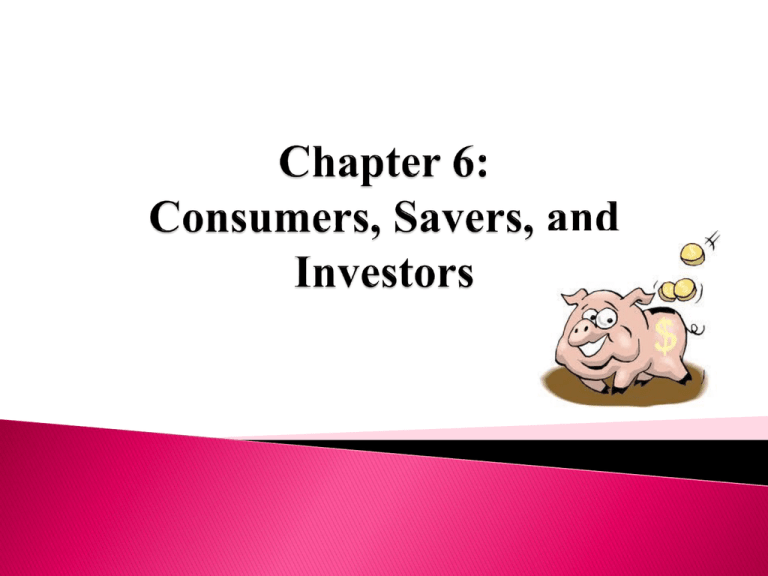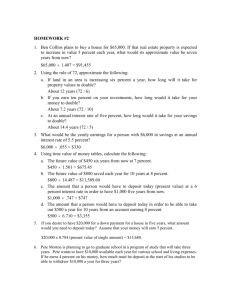Chapter 6: Consumers, Savers, and Investors
advertisement

Final value of all goods and services produced in the country in ONE year When YOU and other consumers spend your money you are taking part in markets for goods and services Before you can become a consumer, you must have money or earn income. Income from work: Wage: earnings paid by the hour or unit of production Salary: earning paid weekly, monthly, or on a yearly basis How much you earn will depend on: ◦ Wage ◦ Salary ◦ ◦ ◦ ◦ ◦ Nature of your job Your skills Your education Your performance Your entrepreneurial drive Middle amount of earnings to be a full-range of earnings for a particular job category Bureau of Labor Statistics: ◦ http://www.bls.gov/oes/current/oes_alph.htm Wealth: a value of the things you own ◦ Adding together the value of all your tangible possessions, bank accounts, savings, and investments gives you the TOTAL amount of your WEALTH = NET WORTH Net Worth: an individual’s wealth after debts and other obligations have been subtracted Rent: payment for the use of someone else’s property Interest: income earned from allowing someone else to use your financial capital RENT IN SANTA ROSA Shared accommodation (room in home or apt.)$350-$750V Vacant 1 bedroom apartment$650-$1200 Vacant 2 bedroom apartment$875-$1350 Vacant 2 bedroom, 1 bath house$1000-$1700 Vacant 3 bedroom, 2 bath house$1200-$2200 Accumulated wealth: initial money and/or assets you earn and the money and assets you add to your initial wealth How do you accumulate wealth? ◦ SAVE A savings account is, of course, a place to stash your money at a bank. However, it can be far more than just a place to keep your cash. Used as part of an overall financial plan, savings accounts can provide: A feeling of financial stability from knowing your principal is safe and the interest income is reliable A pain-free way of tracking and accomplishing your savings goals A financial budgeting tool to help you cover unexpected expenses or selfinsure purchases ◦ INVEST Disposable income: money you take home after taxes are paid Amount people save DEPENDS on THEIR INCOME ◦ Future income ◦ Current rates of interest ◦ Taxation Income levels increase: typical households save and invest more Income levels decrease: people save and invest less Expectations: what people think, or hope, will happen in the future ◦ POWERFUL FORCE IN THE ECONOMY ◦ If consumers are feeling comfortable it will boost the economy by spending more Higher interest rates tend to promote savings Higher interest rates = incentive to save http://www.bankrate.com/comparerates.aspx Government tax rates can encourage or discourage savings Higher taxes on income earned from savings and investments DISCOURAGE people from saving CUTTING taxes on savings and investments encourages people to set money aside for saving and investing Banks, insurance companies, stock brokerages work hard to persuade you to save or invest money…MORE and MORE of your money. IN CONTRAST Businesses try to encourage more spending, stores, movies, etc. YOUR CHOICE: Buy or Save, Buy and Save Need to know: money you receive (income) and how much you plan to spend BUDGET: Personal financial plans ◦ Budget: summarizes an individual’s planned income and spending over a specific time period 3 steps in creating a budget: ◦ Setting financial goals ◦ Estimating income ◦ Planning expenditures Setting financial goals: ◦ Income ◦ Expenditure goals Example: work extra to meet goal Setting an aggressive income goal Possibly college tuition, car payment BE REALISTIC IN SETTING FINANCIAL GOALS! Start with current expenses and add other expenses you know you will be incurring ◦ Example: heating and air conditioning ◦ Example: college tuition Part-time jobs Allowances Gifts Interest on current savings Scholarship ◦ Per diem List all the things you are likely to buy or pay for over the time period of your budget What you need to save to meet your longer-term goals Safety: desk drawer vs. banks/saving institutions ◦ Government sponsored insurance provided by the Federal Deposit Insurance Corporation (FDIC) FDIC = guarantees the safety of any savings account up to $100,00 Rate of return: refers to the percentage of interest or the amount of dividends paid on savings or on an investment ◦ Dividends: products distributed to stockholders Greater rate of return = riskier the investment ◦ WHY??? Let's say you invest $100 in stock, which is called your capital. One year later, your investment yields $110. What is the rate of return of your investment? We calculate it by using the following formula: ((Return - Capital) / Capital) × 100% = Rate of Return Therefore: ◦ (($110 - $100) / $100) × 100% = 10% Your rate of return is 10%. There are two ways to measure the rate of return on an investment. ◦ Average annual rate of return (also known as average annual arithmetic return) ◦ Compound rate of return (also called average annual geometric return) Stock: ownership in a corporation Biggest concern: ◦ STOCK’S VALUE If the price of a company’s stock falls, you can lose much of the money you used to buy the stock = MARKET RISK Market risk: potential decrease in the value of a stock in a stock market Inflation: general RISE on OVERALL prices ◦ Purchasing power of your money decreases One of the main reasons to put your savings into a bank is to earn INTEREST Interest: income earned by allowing a person or institution, such as a bank, to use your money Interest: % of the principal Principal: initial amount of savings ROR: Rate of return: % of the amount on deposit – usually for a period of one year Ex: ◦ Deposit = $1000 ◦ Account = paying 5% annually ◦ Earnings = $50 in interest over a year ROR = 5% Compound interest: interest calculated on the sum of savings plus the accumulated interest ◦ The interest earned is kept in savings To receive CI: ◦ Leave both your initial savings AND ◦ The interest earned in your account Liquidity: the ease with which any asset, such as savings or stock, can be converted to cash ◦ The easier it is to withdraw your funds = the greater your liquidity HOWEVER: liquidity usually has a cost ◦ The easier it is for you to withdraw your money from a bank/savings institution – the lower interest rate your likely to earn ◦ WHY??? If a savings institution – which makes loans from money saved, CANNOT depend on having that money on hand to lend – IT MUST PAY AT A LOWER RATE OF INTEREST Savings deposits: banks, savings/loans firms, credit unions ◦ $100,000 savings: if the bank fails the government will pay the amount you have in savings up to a max of $100,000 Passbook savings account: safety and liquidity ◦ Pay a relatively low interest rate ◦ Minimum balance requirement = low ◦ Liquidity = good, can withdraw money easily CD: receipt issued by a bank to a person depositing money in an account for a specified period of time at a FIXED rate of interest. ◦ Require to leave their money on deposit for a specified period of time, 6 months, 1 year ◦ CD’s pay a higher rate of interest Your best trade-off with a CD is that you give up liquidity for a higher interest rate. Money market deposit account: insured deposit or to write a limited number of checks within a defined time period Use your money market funds to participate in the “money market” “Money market”: consists of short-term loans – usually one year or less ◦ Banks makes its money on the interest it receives on the loans ROI: the depositor (you) receives on these accounts is higher than a Passbook Savings Account and lower than a CD Accounts are safe and offer liquidity Investing in these types of funds provides tax deferment Tax deferment: payment of taxes on interest after the interest is earned – often upon retirements Pension funds: various retirement accounts that people receive through their employers IRA: Individual Retirement Account: ◦ Type of retirement account that an individual can establish with a bank, an insurance company, or a brokerage firm 401 K Plan: for-profit company’s retirement plan that allows an employee to save up to a certain amount of income per year and avoid paying taxes on the income until is withdrawn ◦ Employers will often match a percentage of the employee’s 401K contribution ESOP: Employee Stock Ownership Plan: an employersponsored retirement plan that allows employee’s to purchase the employer’s stock ◦ Often at a reduced price Corporate stocks: ◦ Share of stock: share of ownership in a corporation ◦ Dividends: profits distributed to stockholders Corporate bonds: ◦ Bond: promise to repay borrowed money to a lender at a fixed rate of interest at a specified time Mutual funds: a pool of money used by a company to buy assets – such as stocks and bonds – on behalf of its shareholders Mutual fund companies: special investment companies in which people “pool” their savings to make a variety of investments. ◦ Ex: own stock in 200 different firms ◦ Tends to be less risky (not just one avenue) Issued by the U.S. Treasury Savings Bonds: debts of the federal government ◦ Have face values This amount will be paid to the bondholder when the bond matures Bonds issued at a discount: SOLD at a price BELOW the face of value of the bond Credit: the ability of a customer to buy goods or services before paying for them – BASED ON AN AGREEMENT to pay later ◦ Ex: car loans, mortgages 2 strings attached: ◦ Must repay the principal: original amount borrowed ◦ Pay the interest: amount of money charged for borrowing the principal Finance charge: ◦ Total amount paid to use credit ◦ Includes interest costs and any other fees – a service charge that the seller or lender may be entitled to add to the loan APR: Annual Percentage Rate: ◦ cost of credit calculated as an annual percentage of the principal borrowed Immediate possession: enjoy good and services immediately rather than postponing or do without them. Flexibility: allows people to time their purchases to take advantage of sale items or other bargains, even when their funds are low Safety: safe and convenient means for people to carry their purchasing power while shopping or traveling. ◦ Rather than carrying cash: lost or stolen Emergency Funds: cushion in case of emergency. ◦ Car breaks down. Character reference: pattern of a person’s payment of bills is recorded, called a credit history Overspending: make it too easy to spend money. ◦ Debt mounts, and it is difficult to make the needed monthly payments Higher cost: stores that accept credit cards pay the credit card companies a fee. ◦ Handling the paperwork associated with credit purchases can be expensive for merchants. As a result, stores that accept credit cards typically charge higher prices than those who sell their products only for cash. Impulse buying: ignore sales and special prices because they can buy on credit whenever they want to. Lenders look at 3 things to judge a person’s credit: ◦ Character: personal qualities Honesty and willingness to repay debts Record ◦ Capacity: capability – measure of your ability to repay debts Know about your income sources How much you earn Financial obligations ◦ Capital: what people own Money in the bank or tangible property (a house) More you own the easier it is to repay debts Capital used for security is called collateral Collateral: capital acceptable to a lender for a loan ◦ Ex: automobile is the collateral for an auto loan Failure to pay = take it away Co-signer: a person who has a good credit rating and who guarantees to pay off your loan if you cannot. Good consumer choice: means looking for quality products at the lowest possible prices Government and Consumers: ◦ The right to safety: have the right to be protected from unsafe products ◦ The right to be informed: Exactly what they are buying The terms of the sale and any guarantees accompanying it The kinds of risks that might be involved in the use of a product ◦ The right to choose: Competition is the backbone in free enterprise It is illegal to restrict market competition ◦ The right to be heard: Business and government recognize the need to learn what consumers are thinking (800) numbers or website addresses for customer service Satisfied consumers = key to financial success Goals: ◦ Pay attention to consumer satisfaction ◦ Try and avoid complaints ◦ Respond quickly when consumers point out problems BBB: Better Business Bureau ◦ International organization sets standards for business ethics








